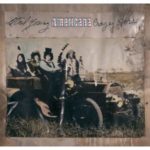
Reprise Records
The first voice you hear on Americana is that of Old Black, Neil Young’s beloved, beat-to-shit, one-of-a-kind Les Paul that has been by his side since the late ‘60s. Old Black barks out a little cluster of close-cropped notes that lead up to a bit of gasoline-and-phlegm-soaked garage raga – the sort of drone and roar that shakes the bicycle pump right off the tenpenny nail driven into one of the 2×4 wall studs. Billy Talbot’s bass rumbles around the cement floor; and Ralph Molina’s drums sound like they’re exploding off the snow shovels tucked overhead in the rafters when he fires off a preliminary roll seven seconds in. The drums diddle with the beat for a few moments as the guitar stretches and groans, everything sounding restless and unsettled.
It’s the bass that finally brings things together with a defined groove at the 0:15 mark, freeing Old Black to get all snaky with a dollop of grunge jazz that pops, burbles, and lurches its way across the fretboard down to the heavy strings like a zombie-eyed Duane Eddy. When Frank “Poncho” Sampedro’s Les Paul begins its own growling chug half a minute in, the package is complete: Neil Young and Crazy Horse have returned, folks. The subject is Americana – and the sonic drama just described would be the opening seconds of Track 1, a rollicking, lumbering version of “Oh Susannah”. Yeah: that “Oh Susannah”.
(A confession: when I first heard the Americana version, I immediately thought, “Oh, man – ol’ Neil has taken Stephen Foster’s tune and applied the groove from Shocking Blue’s “Venus” to it!” Yeah, well – there goes my career as a music sleuth: turns out “Venus” was inspired by Tim Rose’s re-arrangement of “Oh Susannah”, as recorded by The Big Three in 1963 and Tim Rose & The Thorns in ’64.)
Perhaps this collection of covers – everything from folk tunes to doo-wop with a national anthem thrown in for good measure – will mark the last time that critics (and fans) refer to one of Young’s “phases” or “detours” … as if there was something that he was supposed to return to. Sooner or later, it’s gong to become obvious: whether it be a stripped-down acoustic arrangement of a message rooted deep in his heart or this joyously thrashed-out collection of songs by others, it’s all Neil Young’s music … the sound he was guided to by the muse. This is the trip – not a rest stop.
And what a trip it is. Offering up statements on the condition of the world without actually making any statements, Young and Crazy Horse peel back some layers and apply some topical sonic ointment. “High Flyin’ Bird” swoops, soars, and moans its “sit down, can’t fly, oh Lord I’m gonna die blues.” “She’ll Be Comin’ ‘Round The Mountain” is transformed into “Jesus’ Chariot”, its roar and thunder more second-gear diesel than second coming of the Savior. A jaunty butt-slapping-the-saddle rhythm and some ghostly Sons of the Pioneers-style moans manage to both take the edge off the lyrics of “Gallows Pole” and make the song even more haunting; “Tom Dula” is loaded with explosions of Old Black (amp tubes were harmed during the making of this album … they must have been).
In the old days, Crazy Horse was originally a doo-wop group – muscles which they get to flex on Americana’s version of “Get A Job”. (Oh, to hear the late Danny Whitten sing those sha-na-na-nas.) And you be the judge of what tongue is planted firmly in what cheek as the stately grunge of “God Save The Queen” thumps and crashes away – noting the blending-in of lyrics from “My County ‘Tis Of Thee” … by a children’s choir. “Let freedom ring!” is the thought that closes the album.
In the process, the album sounds and feels like old friends playing their asses off and having a hell of a time doing it. Talbot and Molina are masters at distilling a tune’s pulse to its barest essence and driving it home. And why doesn’t Poncho Sampedro receive more credit for his distinctive guitar work? Harnessing this kind of ragged womp and crackling muscle would be enough of a challenge for one guitarist; listen to Sampedro’s deft power weaves with Young, shake your head and smile.
In the end, the experience of listening to Americana can be as shallow or as deep as you want it to be. My advice is to not overanalyze Neil Young’s reasons for rejoining forces with Crazy Horse at this point in time and doling out this collection of songs.
It’s this simple: the muse spoke.
They played.
Enjoy.



No Comments comments associated with this post